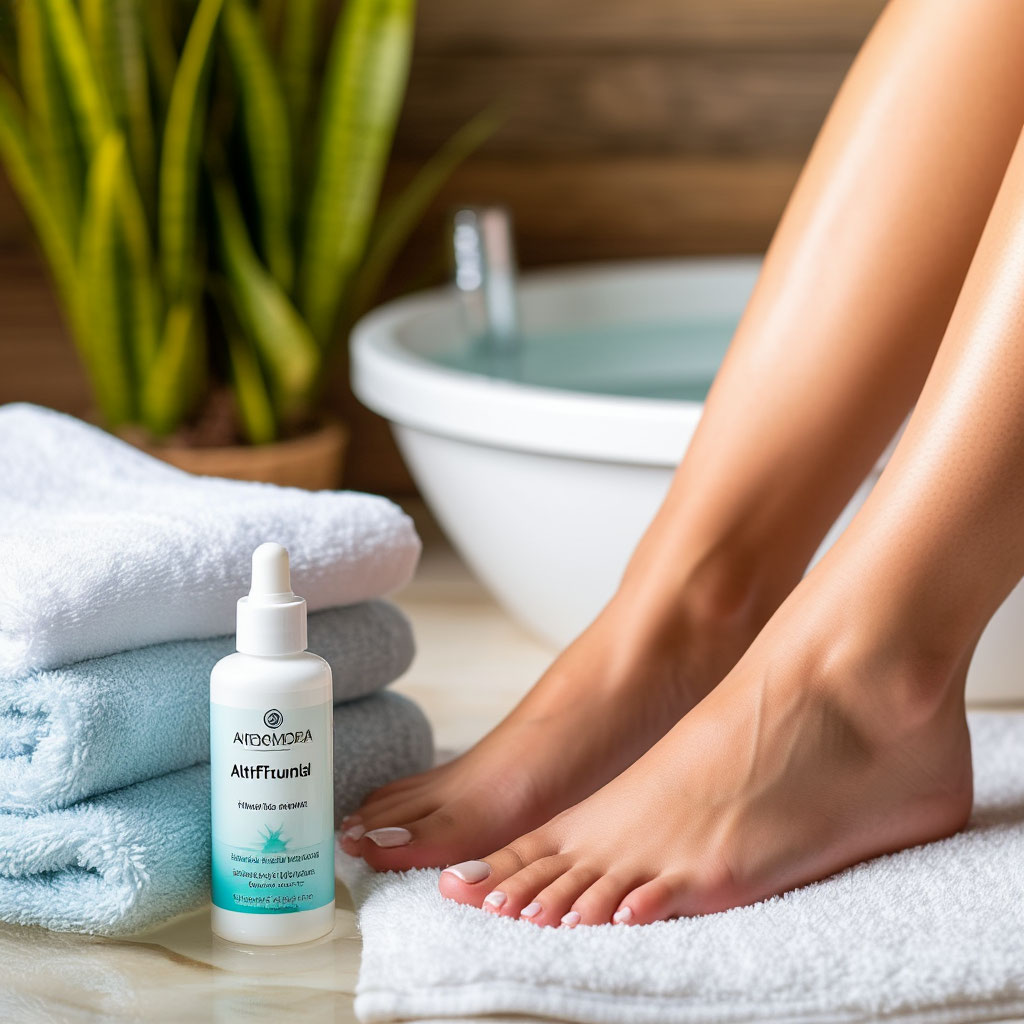Athlete’s foot is a hassle, turning feet into itchy, flaky messes. Those tiny fungi love warm, damp spots, making toes their playground. Folks often wonder if getting a pedicure with athlete’s foot is a bad move. It’s a legit concern—nobody wants to leave a salon with worse issues or spread the infection.
The trick is handling a pedicure with athlete’s foot carefully. Fungal infections don’t rule out pampering, but they demand extra caution. A salon with top-notch hygiene can work. At home, the right steps and products make a difference. From picking a trustworthy salon to choosing antifungal goodies like best antifungal nail polish and knowing when to call a doctor, this article has it covered.
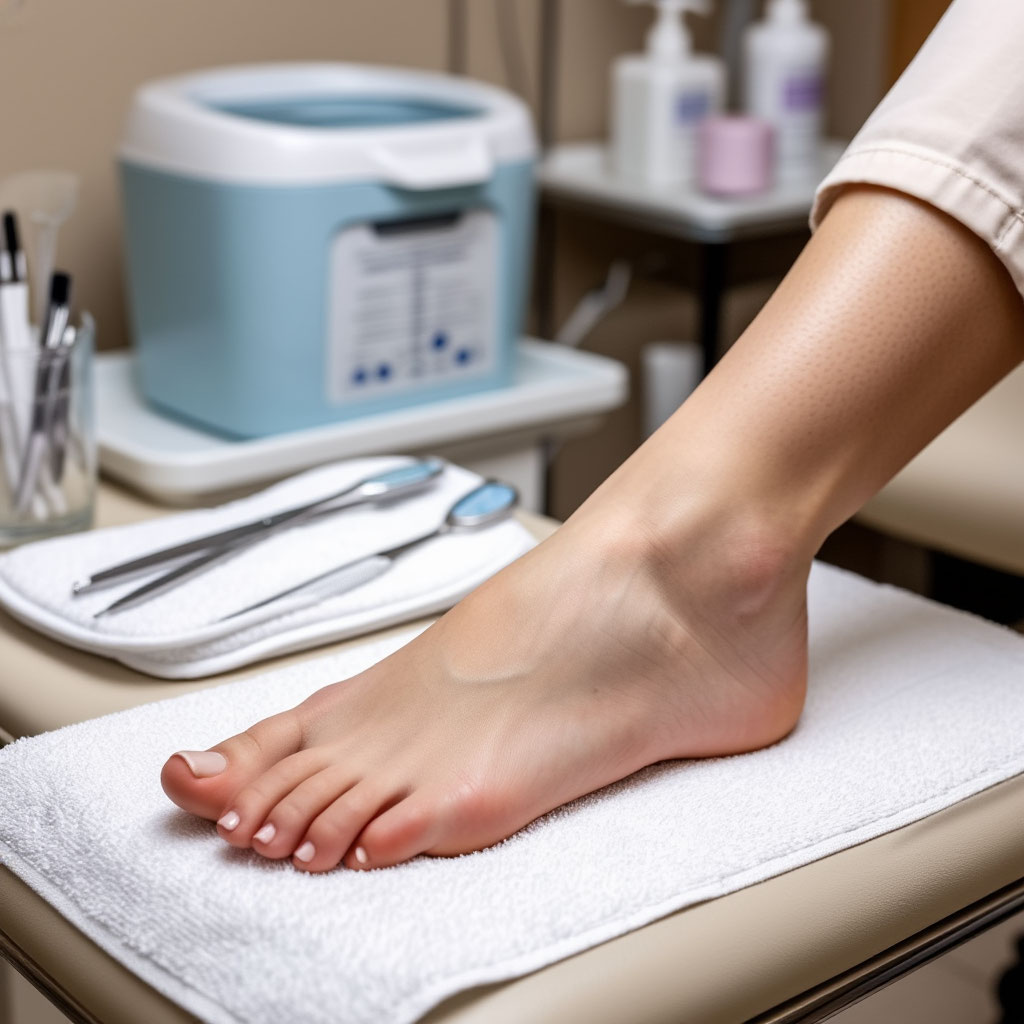
Can You Get a Pedicure with Athlete’s Foot?
A pedicure with athlete’s foot isn’t a straight yes-or-no situation. Fungi like tinea pedis spread fast in moist places like salons. When feet are red, scaly, or itchy, a pedicure might seem like a quick fix to hide the mess. But that can backfire. Salons see tons of clients, and if tools aren’t spotless, cross-contamination becomes a problem.
The worry is spreading the fungus further—to other toes or even other people. Technicians might miss mild symptoms. Shared tools or soaking tubs can carry fungal spores. When someone asks, “Can I get a pedicure if I have fungus?” it depends on the salon’s cleanliness and how bad the infection is. Mild cases might be okay with precautions, but active infections suggest holding off.
What’s the Risk?
Salon pedicures involve water, scrubbing, and clipping—fungus-friendly conditions. Unsterilized tools can move spores to healthy skin. Communal foot baths are another danger zone. Even clean salons aren’t foolproof. For someone with athlete’s foot, these factors could worsen the issue or spread it elsewhere, especially if they don’t know how to disinfect feet after pedicure.
Hiding the problem is another concern. Nail polish might cover yellow nails but traps dampness, letting fungi thrive. Aggressive cuticle work can create tiny cuts, inviting more trouble. It’s not just about the person with the infection—sloppy practices could affect others. Being honest with the salon about the condition keeps everyone safer and ensures a proper pedicure with athlete’s foot.
When’s It Okay to Go?
If the infection is under control, a pedicure might be fine. Doctors suggest waiting until itching or peeling stops. Using antifungal cream for a couple of weeks can calm things down. Even then, picking a solid salon is crucial. Someone with mild or treated athlete’s foot should tip off the technician to use disposable tools or take extra care, especially at salons that treat fungal nails. This cuts risks and keeps the pampering stress-free.
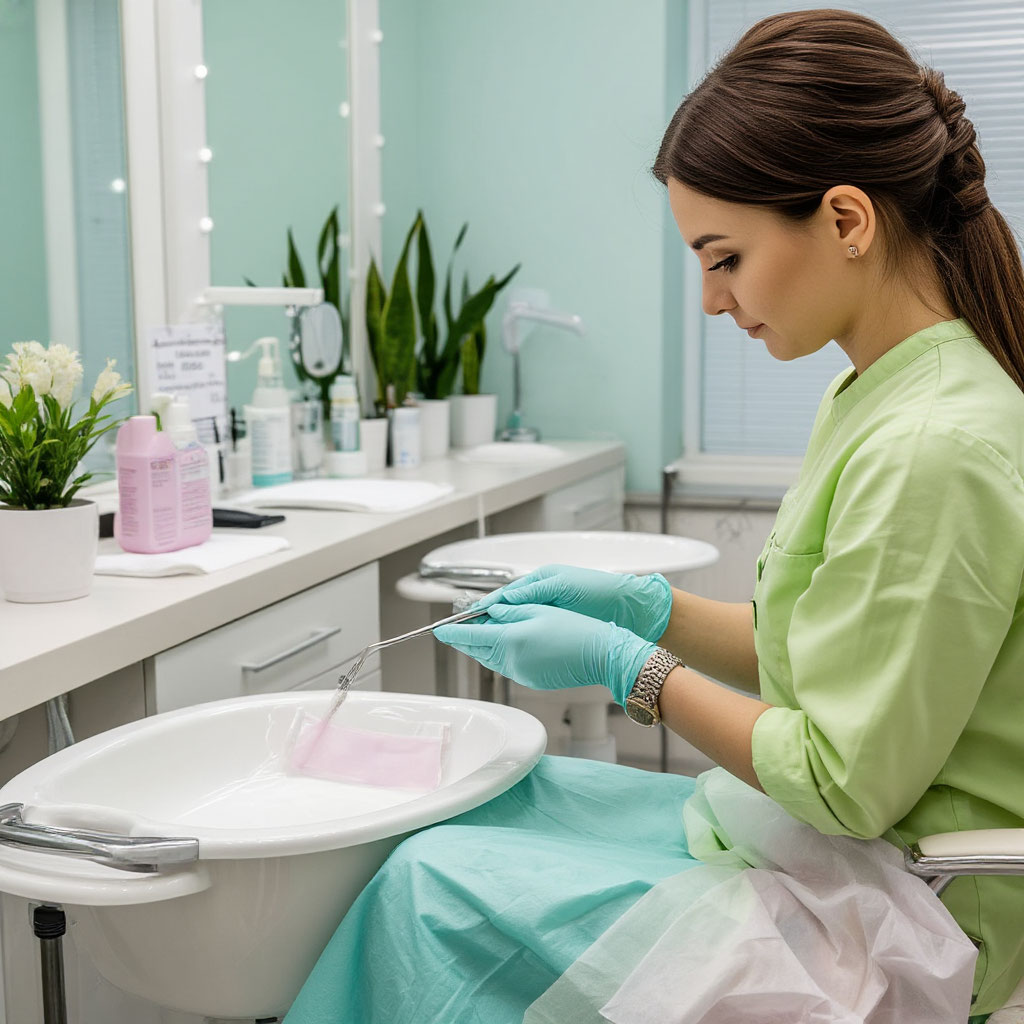
How to Choose a Safe Salon
Finding a good salon matters a ton for anyone with athlete’s foot. Not all salons that treat fungal nails are up to par. Cleanliness is everything when fungi are in play. A great salon doesn’t just make feet look nice—it keeps them healthy. Checking a few things can prevent a fungal nightmare during a pedicure with athlete’s foot.
Start by eyeing the salon’s vibe. Are floors clean? Workstations tidy? A cluttered space often hints at lax hygiene, which could ruin a pedicure with athlete’s foot. Ask how they clean tools. Autoclaves or hospital-grade disinfectants are non-negotiable for metal gear. Some salons that treat fungal nails use throwaway files, which is ideal. Don’t be shy—ask about their process. A good salon won’t mind explaining.
Pedicure with Athlete’s Foot: Definition of First-class Hygiene
Here’s what to check when scoping out a salon:
- Tools sterilized in autoclaves or sealed packets. Disposable options are a plus.
- Foot baths with single-use liners or cleaned between clients. No shared tubs.
- Technicians wearing gloves for fungal cases. It shows they’re serious.
- No double-dipping in wax or creams. Single-use products are safer.
- A neat, organized setup. Messy salons scream trouble.
These signs point to a salon that prioritizes safety. For athlete’s foot, this is a must. Calling ahead to ask about these practices saves headaches. Some spots even offer medical pedicures, perfect for fungal issues. They often have staff trained to handle infections with care, making them ideal salons that treat fungal nails.
Chatting with the Technician
Being upfront is key. Someone with athlete’s foot should tell the technician right away. It’s not about shame—it’s about keeping things safe. A skilled technician will value the heads-up and use fresh tools or skip risky steps. If the salon brushes it off or seems clueless, that’s a cue to leave. A pro will know how to manage a pedicure with athlete’s foot without breaking a sweat, ensuring a clean process and advising on how to disinfect feet after pedicure.
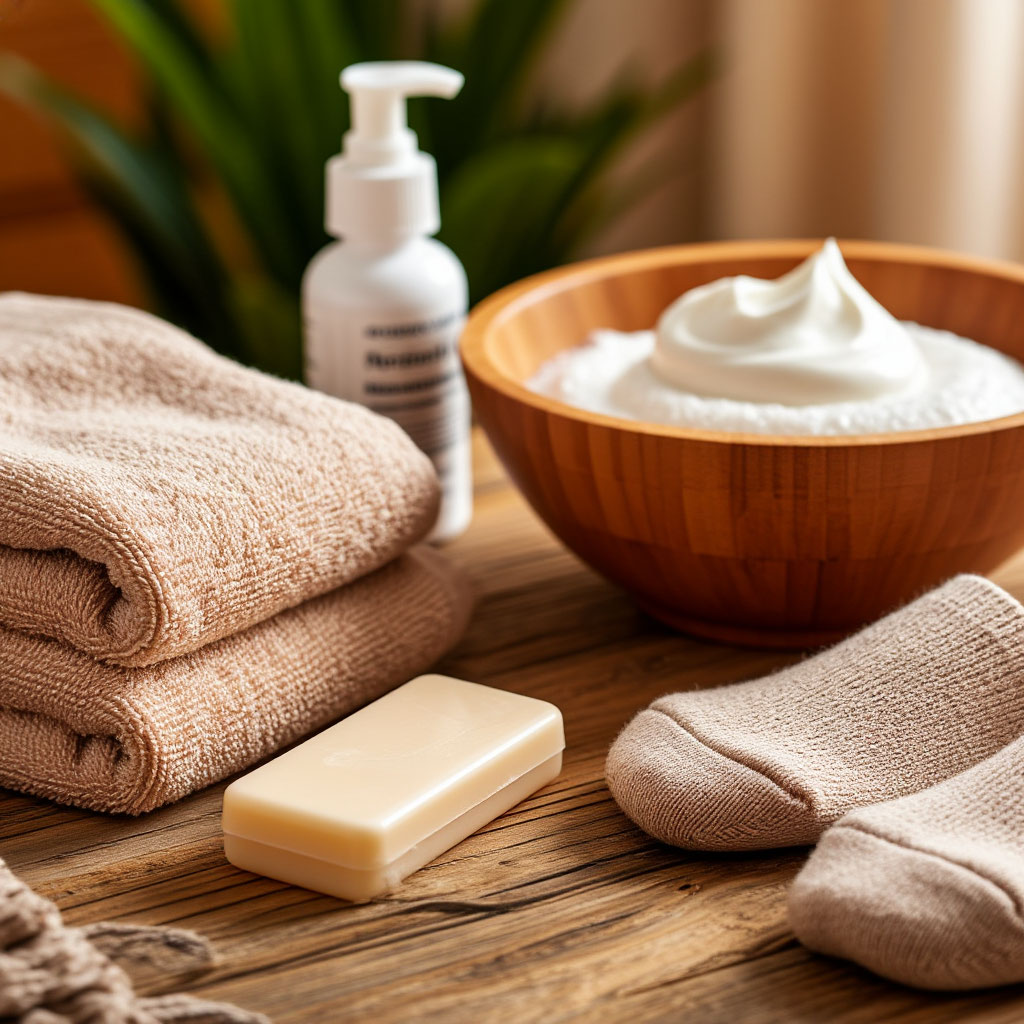
At-Home Pedicure for Fungal Issues
Sometimes, salons aren’t the best bet. Doing a pedicure with athlete’s foot at home offers more control. It’s also a cozy way to treat feet while tackling the infection. The focus is on keeping things clean and using smart products. A home pedicure can feel indulgent and safe with the right approach.
Begin with a clean setup. Wash hands and grab sanitized tools like clippers or files. Soak feet in warm water with Epsom salts to soften skin and ease itching. Keep soaks short—five minutes max—to avoid feeding the fungus. Dry feet well, especially between toes, to disinfect feet after pedicure and stop the spread.
Building a Safe Routine
A solid at-home pedicure needs prep. Use a fresh towel and a clean basin for soaking. Toss in some antifungal powder if available. Trim nails straight to dodge ingrown issues. File rough spots gently—overdoing it can irritate skin, letting fungi dig deeper, which could complicate using best antifungal nail polish later. Finish with a moisturizer safe for infections, like one with tea tree oil.
Tool hygiene is critical. Soak clippers in rubbing alcohol for a few minutes post-use. This ensures tools disinfect feet after pedicure by killing lingering spores. Store them in a dry, sealed container. If sharing a bathroom, keep tools separate to avoid spreading the fungus. A little care here pays off big, especially for those wondering, “Can I get a pedicure if I have fungus?”
At-Home Pedicure Steps
Here’s a straightforward plan for a safe home pedicure:
| Step | Description |
| Soak | Dip feet in warm water with Epsom salts or antifungal powder for 5 minutes. Dry completely. |
| Trim | Cut nails straight across with clean clippers. Don’t cut too close to skin. |
| File | Smooth rough patches with a sanitized pumice stone or file. Go easy to avoid irritation. |
| Moisturize | Rub in antifungal cream or tea tree oil lotion. Target dry spots. |
| Protect | Slip on clean, breathable socks afterward. Cotton or bamboo are great picks. |
This routine keeps feet neat while fighting the infection. It’s easy but works. Doing it weekly helps manage symptoms and prevents flare-ups, especially when paired with best antifungal nail polish.
Products to Avoid & Use
Picking the right stuff for a pedicure with athlete’s foot is a big deal. Some products make the infection worse, while others keep it in check. It’s not just about grabbing any cream or polish. Knowing what to avoid and what to use can change the game. This section sorts out the good from the bad for those asking, “Can I get a pedicure if I have fungus?”
Steer clear of thick, greasy creams like petroleum jelly. They lock in moisture, giving fungi a cozy home. Regular nail polish is a no-go—it traps dampness and masks issues, unlike best antifungal nail polish. Scented lotions might smell great but can irritate sensitive skin. Harsh scrubs or exfoliants are risky, creating tiny cuts where fungi creep in.
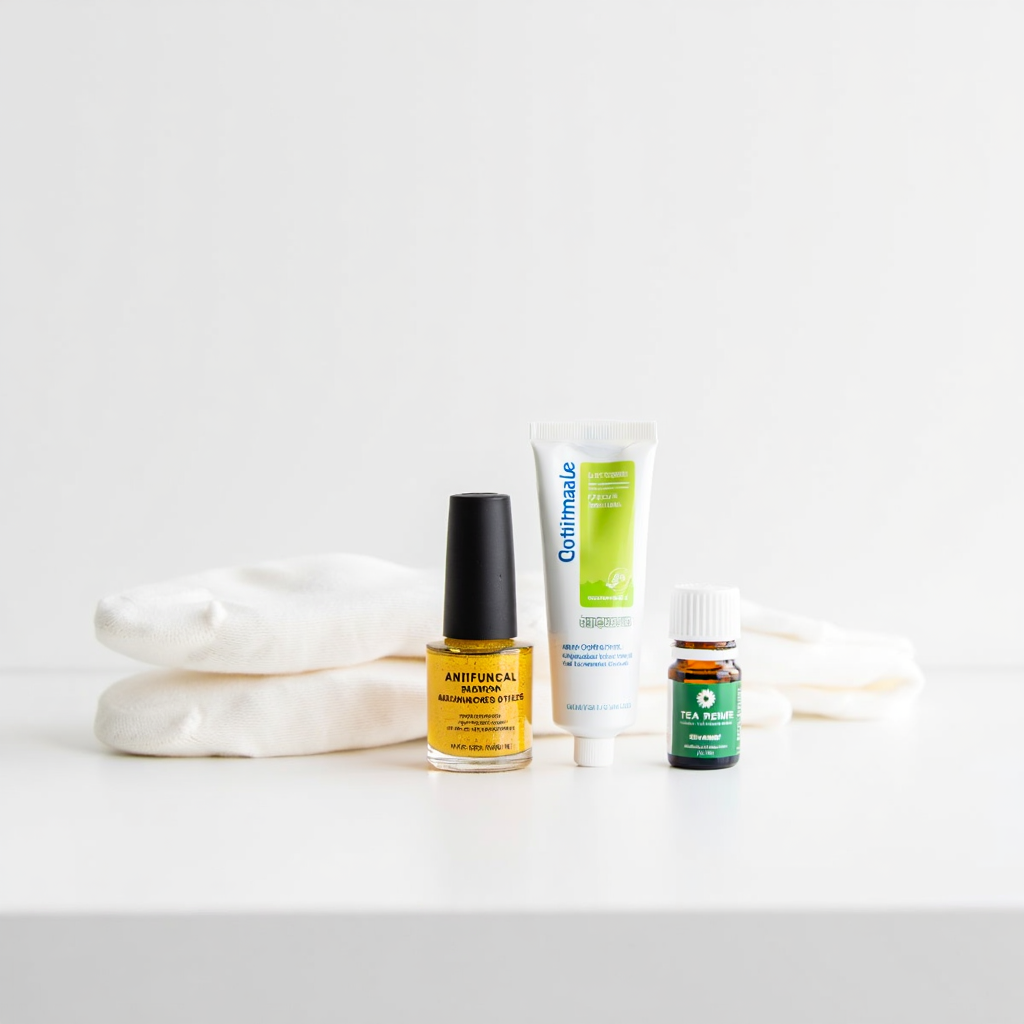
Top Picks for Fungal Care
Here’s what to use or skip:
- Antifungal creams with clotrimazole or terbinafine. They hit the infection head-on.
- Tea tree oil lotions. They’re natural and fight fungi.
- Best antifungal nail polish like Dr.’s Remedy. It breathes and treats the problem.
- Skip regular nail polish. It traps moisture and fuels the fungus.
- Wear breathable socks after products. Cotton or bamboo are solid choices.
These products help manage athlete’s foot while keeping feet presentable. Best antifungal nail polish options, like those with antifungal ingredients, let nails breathe while treating the infection. Always read labels for antifungal properties before buying, especially for salons that treat fungal nails.
How to Apply Them
Using products right is just as important as picking them. Apply antifungal creams twice a day, even after symptoms ease. Rub them into affected spots and between toes. For best antifungal nail polish, use thin layers and remove weekly to check nails. Don’t share products—fungi spread easily, and proper application helps disinfect feet after pedicure. Keeping a separate stash for foot care avoids mix-ups.
When to See a Podiatrist
Athlete’s foot can be stubborn. If a pedicure with athlete’s foot or home care isn’t working, a podiatrist is the go-to. These foot pros can tell if the infection’s more than skin-deep. Lingering symptoms or worsening issues need expert attention. Knowing when to see a doctor can prevent bigger problems.
Itchy, red, or scaly skin that sticks around past two weeks is a warning sign. Thick, yellow, or crumbly nails might mean a deeper issue, often needing best antifungal nail polish or stronger treatments. Pain or swelling isn’t normal and could point to a secondary infection. A podiatrist can run tests and prescribe stronger treatments. They might also suggest salons that treat fungal nails for safer pedicures.
When to Book an Appointment
Some cases need more than over-the-counter fixes. If creams don’t help after a month, it’s time for a specialist. Cracks or blisters between toes can let bacteria in, causing trouble. People with diabetes or weak immune systems should see a doctor sooner—fungal infections hit harder in these cases. A podiatrist can also advise on how to disinfect feet after pedicure to stop the cycle.
What Happens at the Visit
A podiatrist will examine feet closely, sometimes taking a skin or nail sample. They might prescribe oral meds or stronger creams for tough infections, beyond what best antifungal nail polish can handle. They’ll share tailored tips on foot care, like safe products to use. Some offer in-office treatments to speed up healing. Following their advice gets feet back to normal, ready for worry-free pedicures.
Athlete’s foot doesn’t have to ruin foot care plans. A pedicure with athlete’s foot can work with the right steps, whether at a salon or home. Choosing a clean salon, using antifungal products, and knowing when to see a podiatrist keep feet in check. These tips let anyone pamper their feet while tackling the infection. Stay diligent with hygiene, and those toes will be sandal-ready soon, especially with help from salons that treat fungal nails.
